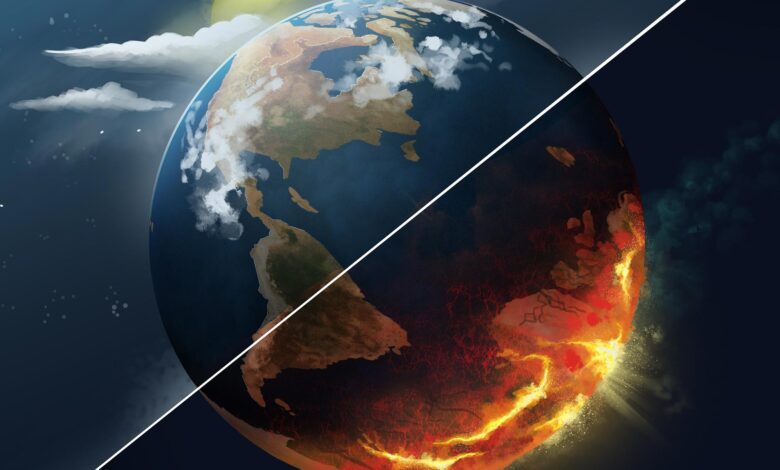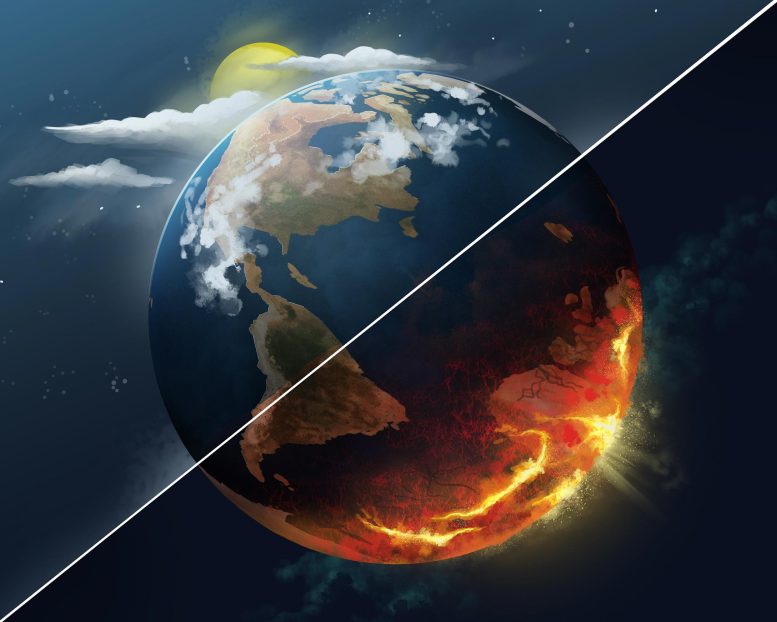How Close Are We to the Climate’s Point of No Return?


A new study underlines the critical importance of adhering to the Paris Agreement’s 1.5 °C warming limit to prevent the destabilization of key Earth systems, stating that current policies might lead to higher global warming and increased tipping risks.
Researchers highlight the severe risks of destabilizing Earth’s tipping elements like ice sheets and ocean currents due to climate change, emphasizing the need to maintain the 1.5 °C limit set by the Paris Agreement to avoid dire future consequences. Failure to adhere to these limits increases the likelihood of tipping events, which are significant changes that could impact global climate stability for centuries.
Anthropogenic climate change could destabilize large-scale components of the Earth system such as ice sheets or ocean circulation patterns, the so-called tipping elements. While these components will not tip overnight, fundamental processes are put into motion unfolding over tens, hundreds, or thousands of years. These changes are of such a serious nature that they should be avoided at all costs, the researchers argue.
In their new study, published today (August 1) in Nature Communications, they assessed the risks of destabilization of at least one tipping element as a result of overshooting 1.5 °C. Their analysis shows how crucial it is for the state of the planet to adhere to the climate objectives of the Paris Agreement. It further emphasizes the legacy of today’s climate (in)action for centuries to millennia to come.
Assessing Tipping Risks Under Current Climate Policies
“While timescales to 2300 or beyond may seem far away, it is important to map out tipping risks to the best of our abilities. Our results show how vitally important it is to achieve and maintain net-zero greenhouse gas emissions in order to limit these risks for the next hundreds of years and beyond,“ explains co-lead author Tessa Möller, scientist at IIASA and PIK. “Our calculations reveal that following current policies until the end of this century would lead to a high tipping risk of 45 percent of at least one of the four elements tipping by 2300.”
Escalating Risks With Rising Global Temperatures
“We see an increase in tipping risk with every tenth of a degree of overshoot above 1.5 °C. But if we were to also surpass 2 °C of global warming, tipping risks would escalate even more rapidly. This is very concerning as scenarios that follow currently implemented climate policies are estimated to result in about 2.6 °C of global warming by the end of this century,” says Annika Ernest Högner from PIK, who co-led the study.
The Urgency of Achieving Net-Zero Emissions
“Our study confirms that tipping risks in response to overshoots can be minimized if warming is swiftly reversed. Such a reversal of global warming can only be achieved if greenhouse gas emissions reach at least net-zero by 2100. The results underline the importance of the Paris Agreement’s climate objectives to limit warming to well below 2 °C even in case of a temporary overshoot above 1.5 °C,“ says study author Nico Wunderling of PIK.
Importance of Limiting Global Warming to 1.5°C
The four tipping elements analyzed in the study are pivotal in regulating the stability of the Earth’s climate system. So far, complex Earth system models are not yet able to comprehensively simulate their non-linear behavior, feedbacks, and interactions between some of the tipping elements. Therefore, the researchers used a stylized Earth system model to represent the main characteristics and behavior and thereby systematically include relevant uncertainties in tipping elements and their interactions.
“This analysis of tipping point risks adds further support to the conclusion that we are underestimating risks, and need to now recognize that the legally binding objective in the Paris Agreement of holding global warming to ‘well below 2°C’, in reality means limiting global warming to 1.5°C. Due to insufficient emission reductions, we run an ever-increasing risk of a period overshooting this temperature limit, which we need to minimize at all costs, to reduce dire impacts to people across the world,” concludes PIK director and author of the study Johan Rockström.
Reference: “Achieving net zero greenhouse gas emissions critical to limit climate tipping risks” by Möller, T., Ernest Högner, A., Schleussner, C., Bien, S., Kitzmann, N.H., Lamboll, R.D., Rogelj, J., Donges, J.F., Rockström, J., and Wunderling, N., 1 August 2024, Nature Communications.
DOI: 10.1038/s41467-024-49863-0



